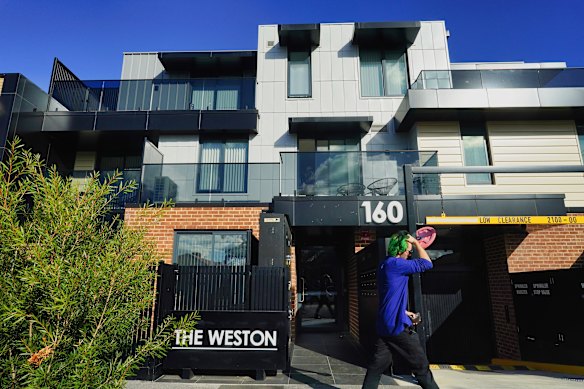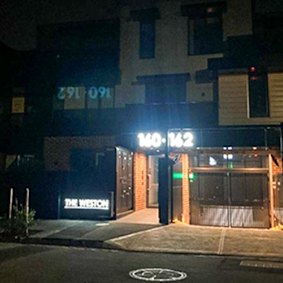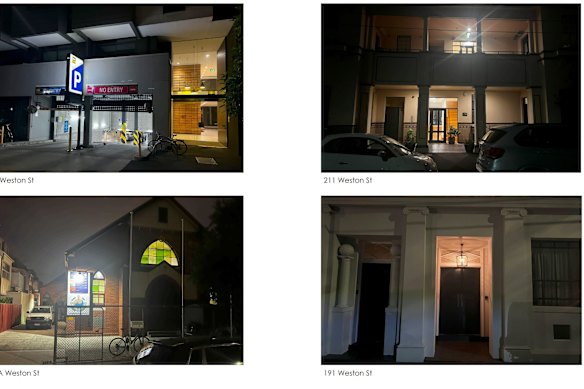By Tom Cowie
A developer has been blocked from switching on a sign to illuminate the name and address of an apartment block after residents living across the street complained that it impacted their sleep.
For around 18 months, signage on the entry to a new three-storey building on Weston Street in Brunswick East lit up at night highlighting the words “The Weston” and the property’s street number in bright white.

The signs at The Weston development in Brunswick East, which will no longer be lit up.Credit: Luis Enrique Ascui
But in November last year, Merri-bek Council issued an amended planning permit for the building with conditions specifying that the sign could no longer be lit up and must remain switched off owing to the glare affecting neighbours.
The Victorian Civil and Administrative Tribunal upheld that decision in a ruling this month.

The signs lit up at night before they were banned.Credit: VCAT
All four properties directly opposite the apartment building had lodged objections, arguing that the signs had affected their amenity and was an unnecessary addition to the property.
“It’s not that we objected to lighting. It was just not being on all night,” said objector Cathy Muraca.
“It’s an eyesore. I mean, do we need light all night? No, we don’t.”
Muraca said the light from the signs had spilled into her front room and those of the other objectors at all times of the evening.
She said it was not an appropriate sign to have operating in a residential area, particularly in such a stark shade of white.
“It’s not a soft white, it’s a really bold white. Neon supermarket white is what we call it,” she said. “It didn’t have to be so big, it could have been turned off on a timer.”

VCAT said the illuminated signs were inappropriate for the area. Credit: Luis Enrique Ascui
Another objector, who asked not to be named, said that the size of the letters, as well as other lights eminating from the development, including the car park, meant it was “lit up like a Christmas tree” at night.
The objector said the impact from the lights meant their front bedroom was constantly illuminated, making it difficult to sleep.
“I had to put up double blinds to counter it, but it still seeped in around the edges,” they said.
“It’s really drawing attention to itself, which is really not part of the aesthetic around here. I’m not quite sure why that needed that kind of advertising.”

Examples of other lighting near The Weston development.
As part of their application to VCAT, the developer said that the lights were appropriate because they helped people find the property and provided passive surveillance for security.
They also argued that the signs were modest in size, a good design and unobtrusive. They also cited several other externally lit up buildings in the area, which is close to Lygon Street, including a carpark and scout hall.
“The client didn’t see there would be an issue,” said architect Joshua Amsellem, who represented the developer in the permit application.
The building’s location near factories and shops, close to a busy part of Brunswick East was also cited as a reason for why the lighting should remain on.
However, VCAT member Christopher Harty said that the illuminated signs were inappropriate for a residential area, where it was important to strike a balance between darkness for sleeping and lighting for public safety.
“The illumination of the signs reflects a white light which creates a contrast to the streetscape at night with local street lighting,” he wrote in his ruling.
“[It] is out of place with the appearance of the area and the character of this residential area and not sensitive to residential amenity.”
A proposal by the developer to dim or turn off the lights between 11pm and 7am was rejected.
Harty said the lit-up signs were unnecessary for showing the address of the property.
“The signs as they are, non-illuminated, provide sufficient site identification that is appropriate for the context of the site,” he wrote.
Start the day with a summary of the day’s most important and interesting stories, analysis and insights. Sign up for our Morning Edition newsletter.